RISCRIVENDO LO SCENARIO DI FORMAZIONE
DEL BULGE GALATTICO
RISCRIVENDO LO SCENARIO DI FORMAZIONE
DEL BULGE GALATTICO
A popular model for the formation of the Milky Way bulge, as well as of elliptical galaxies and spiral bulges, is the so-called "monolithic collapse", according to which these structures formed all at once from a single collapsing
cloud. This is, however, still largely debated in the literature, also because growing body of evidence suggests that galaxy bulges are generated, instead, through the merging of primordial massive clumps of gas and stars, as those actually observed in high redshift star-forming galaxies. While the “merging scenario” appears to be extremely successful in describing the bulge assembling in external galaxies, no direct observational evidence of this process was ever obtained for the Galactic bulge. This naturally raises the following question: Did the Galactic bulge also form in this way? If so, why no fossil relics of this assembling process have ever been found?

Illustrative scheme of the “monolithic collapse” process, bringing to the formation of a bulge (or an alliptical galaxy) from the rapid collapse of a gas cloud.
Credits: 2004 Pearson Education, publishing as Addison Wesley


Images of “clumpy” spiral galaxies observed at high redshift (the redshift value is marked in the left corner of each panel). The giant clumps that bring to the formation of bulges via repeated mergers are well apparent. The images have been acquired in the Great Observatory Origins Deep Survey (GOODS) with the Hubble Space Telescope. From Elmegreen et al. 2009.
“This was the key question that guided our research already 15 years ago, when we started this project. In fact, although the vast majority of the primordial fragments is expected to dissolve to form the bulge, simulations show that a few of them could survive the total disruption and be still present in the inner regions of the host galaxy, grossly appearing as massive globular clusters. At odds with genuine globular clusters, however, these fossil relics should have been massive enough to retain the iron-enriched ejecta of supernova explosions, and possibly experienced multiple bursts of star formation. As a consequence, they are expected to host multi-iron and multi-age sub-populations”, says Prof. Ferraro, from the University of Bologna (UniBO) and associated to INAF, lead author of the study.
Following this route, the team led by Prof. Ferraro discovered the first candidate fossil relic in the Galactic bulge in 2009. This stellar system, named Terzan 5, had all the expected properties and was like no other star cluster known so far: in spite of its globular cluster appearance, it contains both a stellar population remarkably similar the most ancient objects in the Milky Way (12 billion years old), and another much younger population (just 4.5 billion years old) made of iron-enriched stars. “This discovery allowed us to initiate a new line of investigation, aimed at disclosing other similar structures that could be still hidden in Galactic bulge”, adds Prof. Barbara Lanzoni (from UniBO and associated to INAF), co-author of the paper.
The image of Terzan 5 that revealed
its true identity back in 2009.
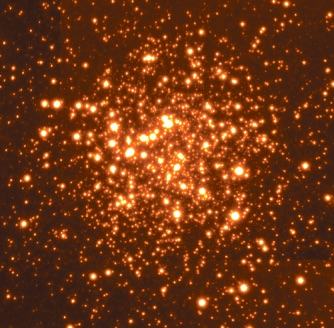
Artistic view of the Milky Way illustrating the position of the Bulge with respect to the Sun (thus, the Earth). Before reaching our telescopes, star light has to travel across thick dust clouds that aborb a large fraction of it.
This is an image of the NGC 4565 galaxy, which is very similar to the Milky Way. Credits: ESO
“Unfortunately, the deep exploration of the Galactic bulge is not an easy task. In fact, this is the most inaccessible region of our galaxy, where thick clouds of dust severely dim star light, especially at optical wavelengths (indeed, a huge extinction, reaching up to 10 magnitudes, affects all the observations at optical wavelengths)”, say Dr. Elena Valenti, from the European Southern Observatory in Germany, co-author of the paper. This means that a star located behind these clouds, if observed in the optical band (the wavelengths that can be perceived also by the human eye), can be seen up to 10,000 times fainter than it is in realty! Fortunately, however, infrared radiation can travel across these clouds and bring us direct information on the emitting sources. Thus, near-infrared observations were crucial for this research. “Indeed, we needed something more than simple near-infrared observations. Our aim was to resolve the inner part of high-density stellar systems, and we therefore needed a special combination of qualities: high-resolution images in the near-infrared bands”, adds Dr. Cristina Pallanca (UniBO and associated to INAF), co-author of the paper.
“The solution come from a technical jewel named GeMS (for Gemini Multi-conjugate adaptive optics System), in combination with the powerful infrared camera GSAOI (for Gemini South Adaptive Optics Imager) at the 8 m telescope Gemini South on Cerro Pachón, in Chile”, says Dr. Francesco Mauro, from the Universidad Católica del Norte (Chile), co-author of the paper.
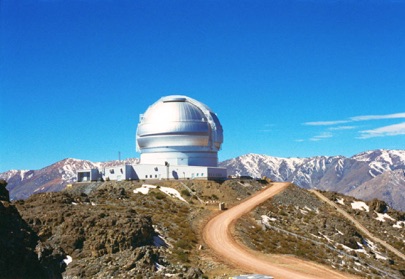
The Gemini South telescope on the top of Cerro Pachón, at 2737 m altitude, in Chile.
Credits: Gemini Observatory/AURA
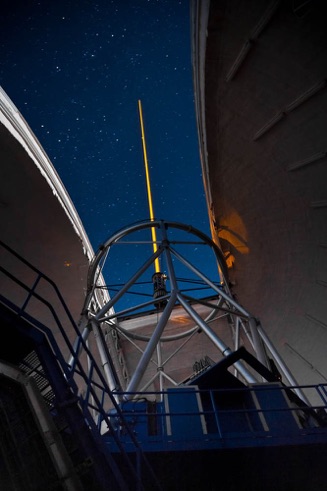
“The superb performances of this instrument were exactly what needed to successfully conduct this unprecedented search. In fact, not only it operates at near-infrared wavelengths (where the dimming effect of star light due to dust is largely reduced), but it also provides very high angular resolution”, adds Dr. Emanuele Dalessandro, from the INAF-Astrophysics and Space Science Observatory of Bologna, co-author of the paper. This means that individual stars can be distinguished even in the overcrowded central region of compact stellar systems, with a resolution comparable to that of the Hubble Space Telescope (HST) orbiting our planet. This is made possible by a multi-conjugate adaptive-optics system, an innovative instrument able to efficiently remove the distortions that the turbolence of the Earth atmosphere causes on astronomical images. The necessary correction is calculated through a real-time analysis of three natural stars and a constellation of five laser stars. “With this powerful instrument we started a systematic exploration of several massive star clusters in the Galactic bulge, searching for Terzan 5 twins. The top-priority target was Liller 1, one of the most massive and most heavily obscured globular clusters in the Bulge”, continues Ferraro.
The Gemini South laser propagating into the sky: this is how the “laser stars” necessary to correct the astronomical images from the distortions caused by the Earth atmosphere are generated. Credits: Gemini Observatory/AURA
“In 2015, we finally obtained a superb set of near-infrared images of Liller1, with unprecedented sharpness: in the best K-band exposures, the star images have an angular dimension of only 75 milli-arcseconds, meaning that GeMS performed an almost perfect correction of the atmospheric distortions“, comments Prof. Doug Geisler from the University of Concepción (Chile), co-author of the paper and principal investigator of the Gemini observations. These data finally allowed the first deep exploration of Liller 1, although they were not conclusive.
The extraordinary K-band image of the central region (15"x15") of Liller 1 acquired with GeMS/GASOI at the Gemini South telescope. The angular size of each star is just 0.075".
Image Credit: F.R. Ferraro/E. Dalessandro (Cosmic-Lab - UniBO)
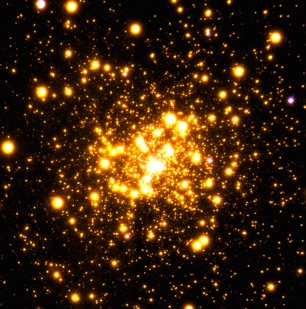
“As expected, this first study put into evidence the presence of a very old population (with an age of 12 billion years), demonstrating that Liller 1 formed very early in the history of the Milky Way”, says Dr. Sara Saracino, from the Liverpool John Moores University (UK), co-author of the paper. However, something strange was visible in that colour-magnitude diagram: the presence of a blue sequence of stars, mimicking a young population. Unfortunately, no firm conclusions could be drawn from that clue alone, because the system is located deep into the Bulge, where it is really hard to distinguish the stars belonging to Liller 1, from those orbiting within the Galaxy and being just aligned along the same line of sight. In any case, a doubt (together with a hope) naturally raised: could Liller 1 be an object similar to Terzan 5?
To answer this question complementary observations, similarly sharp and deep, were needed. Surprisingly, no deep optical images of Liller1 had been acquired with the HST over its 30-year activity. Incredible!
“To remedy this lack, we promptly asked to secure HST ultra-deep observations of Liller 1 in the V and I bands, and we got time. It was the first time that the sharp eyes of Hubble observed Liller 1 at optical wavelengths!”, explain Ferraro, who was also the principal investigator of the HST observations. At this point, the best observational dataset obtainable with the current generation of instruments was secured for Liller 1, the best ever collected both in the optical and in the near-infrared bands.
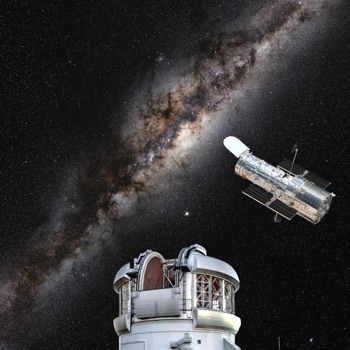
Artistic image of the Gemini South e the HST both observing Liller 1 in the Galactic bulge (Image Credit for the Milky Way panorama: ESO/S. Brunier). The optical HST images used in this study are the first ever acquired for Liller 1.
Image Credit: F.R. Ferraro/C. Pallanca (UniBO)
“The detailed analysis of the HST and Gemini datasets clearly unveiled a weak point (a weak band, indeed) in both of them: at optical wavelengths, the V-band exposures were much shallower than those in the I-band, while in the near-infrared, the observations were limited by the J-band images. At this stage the optimal solution could be only one: combining the two deepest available exposures, those in the K and in the I filters”, says Chiara Crociati, co-author of the paper who just started her PhD at UniBO.
The combination of the two datasets was a long and complex process. However, it led to the solution of problems that were hampering a clear reading of the results. First, it allowed the correction for the effects caused by the dust differential extinction, which spread out and distort the evolutionary sequences in the colour-magnitude diagram, making difficult their interpretation. Second, it allowed the measure of stellar proper motions, to safely distinguish Liller 1 member stars, from Galactic field interlopers.
The resulting hybrid (near-infrared/optical) colour-magnitude diagram, corrected for differential reddening and built-up by using just Liller 1 member stars, was unprecedentedly deep, sharp and accurate, and it finally unveiled the true nature of the stellar system. “The presence of two stellar populations with drastically different ages was clear-cut: the oldest component was the same already found in the previous study, with an age of at least 12 billion years, while the second had never been revealed before and has an age of just 1-2 billion years! We finally discovered another stellar system similar to Terzan 5 in the core of our galaxy!”, adds Prof. Mike Rich from the University of California (USA), co-author of the paper.
The first optical image of Liller 1 ever obtained with the HST (left) and the near-infrared image acquired with the Gemini South (right). The combination of these extraordinary images finally allowed the astrophysicists to unveil the true identity of Liller 1: for the first time, this system has been discovered to host two distinct stellar populations, a very old one (approximately 12 billion years old), and another component that was generated just 1-2 billion years ago.
Image Credit: F.R. Ferraro/C. Pallanca (UniBO)
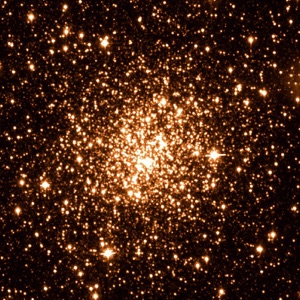
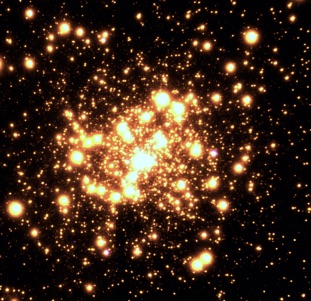
The properties of the old stellar populations observed in Liller 1 and Terzan 5 demonstrate that both these systems formed very early, at the epoch of the Milky Way assembly. On the other hand, the young populations appear to be more iron-rich and more centrally segregated than the old components, in agreement with what expected in a self-enrichment scenario, where the youngest stars form from gas chemically enriched by the previous generation. This confirms that the progenitors of both Liller 1 and Terzan 5 were massive enough to retain the gas ejected by supernova explosions. The observational facts collected so far clearly indicate that these objects are far from being globular clusters, and define, instead, a new class of stellar systems, the remnants of primordial massive structures that formed in situ and contributed to generate the Bulge approximately 12 billions ago. A new class of objects thus named "Bulge Fossil Fragments (BFFs)".
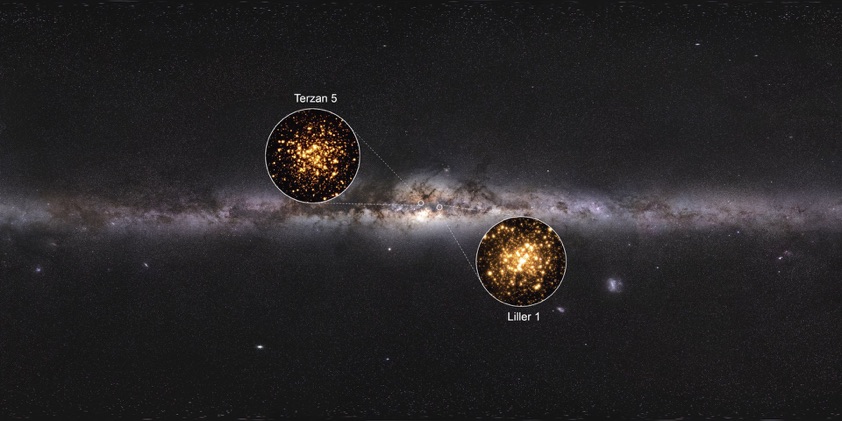
Image of the Milky Way in the direction of the Galactic centre (Credit: ESO/S. Brunier), with the positions of the two Bulge Fossil Fragments identified so far (Liller 1 e Terzan 5) highlighted. The dark spots on light backgroud are thick dust clouds absorbing the light emitted by the sources behind them.
Image Credit: F.R. Ferraro/C. Pallanca (UniBO)
Which are the distinctive properties of the Bulge Fossil Fragments?
These systems (1) are indistinguishable from genuine globular clusters in their appearance, (2) have metallicity and abundance patterns compatible with those observed in the Bulge field stars, (3) host an old stellar population (testifying that they formed at an early epoch of the Milky Way assembling), (4) host a young stellar population, several to many billion years younger than the old one (testifying their capacity of triggering multiple events of star formation).
“Like archaeologists who dig through the dust piled up on top of the remains from past civilizations, and unearth crucial pieces of the mankind history, we have been gazing through the thick layers of interstellar dust obscuring the bulge of the Milky Way, unveiling an extraordinary class of cosmic relics”, comments Dr. Livia Origilia from INAF-Astrophysics and Space Science Observatory of Bologna, co-author of the paper.
Following the archaeology example, one fossil can say just little on the global scenario: it could be there only because of a sequence of random events. Instead, the discovery of a second similar fossil in the same site indicates that something much more complex and significant is likely hidden under the dust. Similarly, the discovery of Liller 1, after that of Terzan 5, is indicating that other fossil relics (possibly, many) could be still hidden below the thick clouds of dust obscuring the Bulge.
“We now need to dig deeper into the Bulge! As in a sort of “Rosetta Stone”, in these fossil relics is imprinted the history of the Milky Way formation (and of the first cosmic structures), at the time when the Universe was just a baby, only one billion year old. We can now finally start to read this stry!”, concludes Ferraro.
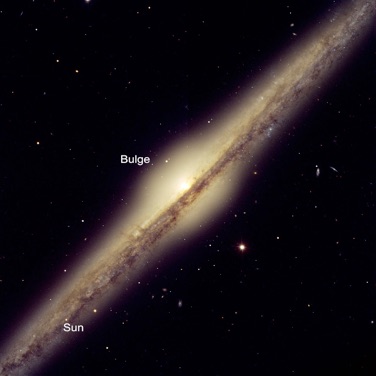
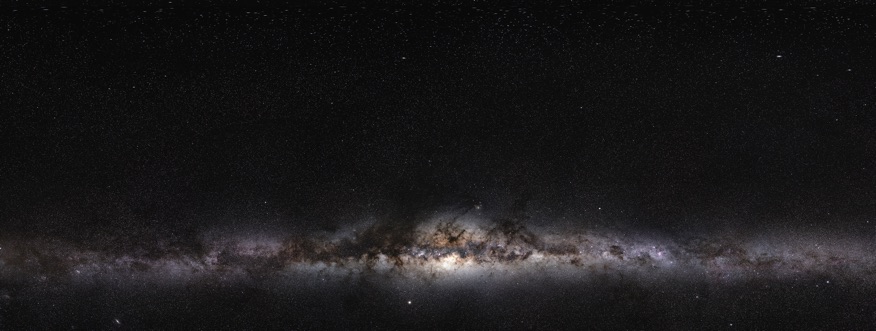
Redesigning the assembling history of the
Galactic Bulge
While observations of the distant Universe show that the central part (bulge) of spiral galaxies form through the merging of primordial massive clumps of gas and stars, no evidence of this process has been found so far in the Milky Way. Thanks to a powerful synergy between the Gemini South telescope in Chile and the Hubble Space Telescope, a new class of stellar systems (named “Bulge Fossil Fragments”) has been discovered in the Mily Way bulge: they are the fossil relics of that assembling process. The discovery has been published in the Monday 14 December 2020 issue of the prestigious journal Nature Astronomy and it is the result of a study performed by an international team of astrophysicists led by Francesco Ferraro, professor at the Physics and Astronomy Department “Augusto Righi” of the Bologna University and associated to the Italian Astrophysics National Institute (INAF).
Credit: ESO/S. Brunier


People ivolved in the project
University of Bologna: Francesco R. Ferraro, Cristina Pallanca, Barbara Lanzoni, Chiara Crociati, Alessio Mucciarelli
INAF-OAS: Emanuele Dalessandro, Livia Origlia
University of California (USA): R. Michael Rich
Liverpool John Moores University (UK): Sara Saracino
European Southern Observatory (Germany): Elena Valenti, Giacomo Beccari
University of Conception (Chile): Douglas Geisler, Sandro Villanova
Universidad Católica del Norte (Chile): Francesco Mauro, Cristian Moni Bidin

For any additional information please contact
Francesco Ferraro
email: francesco.ferraro3@unibo.it
tel: +390512095774
mobile: +393666357560
